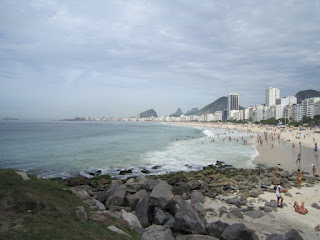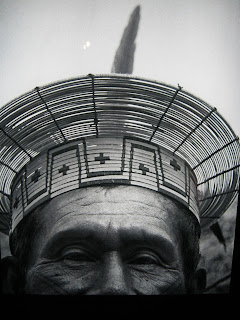Copacabana is not my neighborhood, and I do not often venture out to see or do things there, but one thing has been on my list for a while. To try macarons! And in Copacabana a few years ago a French baker set up a French bakery, with, yes, you guessed it: all the fantastic French croissants, pastries, tarts and macarons!
Today I was close by and decided to give it a try.
It looked really chic! And it was...
And the macarons? They were even more wonderful than I had imagined! And so beautiful!
Happiness is sometimes very simple!
domingo, 21 de fevereiro de 2016
Number 23 - Caminho dos Pescadores, Leme
One of the things that I discovered when I made my vision board for 2016 was the "theme" of the beach. I am definitely not a beach lover, but I live in a city where the beach is the equivalent to a park in other cities. It is where you go to relax, to meet your friends, to practice sports and eventually to sunbathe! So I am making finding "my beach" one of my goals this year.
On this Sunday morning I set out to go to Leme. Leme is the left hand corner of the famous Copacabana beach, when you stand facing the sea. It is usually less crowded than Copacabana, and usually more of a family part of the beach. I was out to see the "Caminho dos pescadores" - the Fishermen's path.
I knew that the path was at the base of Morro do Leme, which I could see in the distance.
It was still pretty early in the morning, not so many people on the beach yet, but lots on the "calçadão" - the beach promenade.
As I was getting closer to the hill, the whole of Copacabana beach came into view.
I started up the path, where there were already lots of fishermen and some tourists like myself.
And from the path I got a new view of Copacabana, and even on a day that was not tropically picture perfect the ocean was a surprising greenish blue.
The fishermen where all lined up, not catching much as far as I could see, but then I suppose fishing is not all about catching fish...
The path is really short, so I stood taking in the sight for a while then made my way back.
As I left the path I saw a military band all lined up and got curious - what or who were they waiting for?
Turned out it was hundreds of soldiers running for peace.
And I realized that behind me there was a military fort and a green area, there is a trail there up to the top of Morro do Leme, but I decided to leave that adventure for my next visit.
On this Sunday morning I set out to go to Leme. Leme is the left hand corner of the famous Copacabana beach, when you stand facing the sea. It is usually less crowded than Copacabana, and usually more of a family part of the beach. I was out to see the "Caminho dos pescadores" - the Fishermen's path.
I knew that the path was at the base of Morro do Leme, which I could see in the distance.
It was still pretty early in the morning, not so many people on the beach yet, but lots on the "calçadão" - the beach promenade.
As I was getting closer to the hill, the whole of Copacabana beach came into view.
I started up the path, where there were already lots of fishermen and some tourists like myself.
And from the path I got a new view of Copacabana, and even on a day that was not tropically picture perfect the ocean was a surprising greenish blue.
The fishermen where all lined up, not catching much as far as I could see, but then I suppose fishing is not all about catching fish...
The path is really short, so I stood taking in the sight for a while then made my way back.
As I left the path I saw a military band all lined up and got curious - what or who were they waiting for?
Turned out it was hundreds of soldiers running for peace.
And I realized that behind me there was a military fort and a green area, there is a trail there up to the top of Morro do Leme, but I decided to leave that adventure for my next visit.
Number 22 - Museu do Indio
February has almost come to an end, and the blogger knows time is running out! But February this year has also been the month of the carnival, when everything in Rio simply stops to let the the bands and the participants march and dance for a week. The blogger, going on fifty, decided a long time ago that carnival was great, but once or twice was enough! Nowadays, a few days to just rest and take it easy is carnival my way.
It is well-known that in Brazil the new year only starts after carnival, and that pretty much sums up the last week. It is time for 2016 to start! Time for museums to open up again, and I decided to check out the Museu do Indio - The Museum of the Indian in Botafogo. Housed in an old mansion built in the 1880's it is a cultural an scientific agency for FUNAI - the National Foundation of the Indian. It was created by Darcy Ribeiro in 1953, and that should have been reason enough for me to have visited the museum a long time ago. Darcy Ribeiro was a Brazilian anthropologist, and his books have been very important in my quest to try to understand Brazil.
It was a scorching afternoon, but the garden surrounding the museum was green and inviting, and, fortunately, the old mansion had great air conditioning. There were several exhibits I started by the one called " Miçangas".
Miçangas or glass beads are used among the Indians to produce jewelry, art, headgear, and ritual clothing. Even if many tribes used seeds of different kinds before the Europeans came and offered the glass beads, in order to trade them for other more precious goods, most of them were fascinated by the glass beads and incorporated them in their traditional creations.
The exhibit is beautiful, with videos, interactive devices and the stories behind the different artifacts, but unfortunately there is no information in English.
I was fascinated by these delicate bowls.
And how can one not be impressed by this incredible outfit?
The exhibition also shows how the glass beads have traveled all over the world, and how they are used in many cultures.
This is an example from Brazil, but glass beads are used in the national costumes in my native Norway, as this picture shows.
But there was more to see! After visiting the little store that sells objects made by many different tribes, I went on to see the exhibit called: "Ashaninka - O poder da beleza" This exhibit about the myths and the beauty of the Ashaninka people who live in the Amazon in Brazil and Peru was completely different but just as interesting.
I came out in the sunshine again and thought about the fact that I know so very little about the Brazilian Indians. They live all over Brazil, but are not very present in the Brazilian society. The museum has the objective of promoting an accurate and updated image for the indigenous cause, while avoiding common misconceptions and prejudice of these societies. There is still a long way to go in Brazil, where the Indian people are still fighting for their rights.
The statue of General Rondon who created FUNAI, and was responsible for creating a new political respect for the Brazilian Indians, is symbolically merged with a statue of an Indian. It seemed to me that this statue represented the spirit of the museum, and from the garden Christ -The Redeemer, watching over it all, could be seen. It was time to head home.
Assinar:
Comentários (Atom)










































